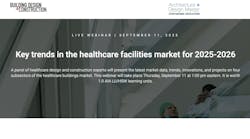Sustainable Buildings as Teaching Tools: 4 Strategies for Integrating Buildings into Experiential Learning
The goal of CIRS is for people to see buildings not just as machines that happen to be occupied, but to see buildings and their occupants as living, adapting systems in which the building can learn from the occupants and the occupants can learn from the building. CIRS goes further by connecting to nearby buildings and systems on campus, hoping that students will learn from the way the building operates and eventually improve efficiencies.
Buildings, which account for 60% of global energy consumption and 40% of landfill waste, are a lynchpin for universities wanting to make a visible, tangible improvement on their environments. Many are also recognizing the ability of buildings and their systems to serve as teaching tools and enhance the curriculum and overall learning experience of students on campus.
The Ohlone College Newark Center for Health Sciences and Technology in Newark, Calif., has academic programs focus on the growing fields of biotechnology, environmental studies, emerging technology, and health sciences. The campus has received LEED Platinum certification and the alternative energy systems are highly visible to the entire campus population to promote environmental awareness and conservation.
For example, the enthalpy wheels showcase the energy savings in real time, so students, faculty, and visitors can see how the systems work and how much energy is conserved. The geothermal system shows water temperature as it enters and exits the system, demonstrating the earth exchange process and showing the amount of energy saved by the system.Photo 5, (Students & Staff) Viewing Enthalpy Wheel at Work, Ohlone College Newark Center for Health Sciences and Technology (Robert Canfield)Universities have long recognized that the learning process occurs throughout a student’s college experience. Incorporating buildings into this holistic experience is a creative and inventive way to continue to expand the learning experience outside the classroom, no matter the discipline a student is studying. Environmentalism, a movement that has swept onto the university campus more pervasively perhaps that in any other setting, often began as a grassroots movement among students. Using buildings as teaching tools is a clear, visual way to engage students’ interest and desire for their environment to reflect their values.
Here are a few strategies to creatively integrate buildings into experiential learning, both in and out of the classroom:
1. Use visible symbols of environmental responsibility. Photovoltaic panels, green roofs, constructed wetlands, sunlight and views, and operable windows can be easily indicated as elements of a green building. Signage, in expected or unexpected areas, is also an efficient way to explain the sustainable features of a new building.
Foothill College in Los Altos Hills, Calif., was built into a hillside; to help it blend in with the natural surroundings, the college incorporated a green roof as part of the design solution. This feature clearly shows the students how integrating a building into a hillside can benefit the environment. The grasses on the green roof will change with the seasons, and will match up the surrounding vistas on site, because the college used surrounding grasses and minerals in the green roof.Arial Image of Foothill College (Perkins+Will)2. Integrate a ‘smart’ building management system into kiosks or public displays. Building operations are often hidden and only accessible to facilities staff. New “smart” management systems can monitor the operations of HVAC systems as well as the utilization of photovoltaic panels, geothermal heating, and other sustainable features in an interface that is readable by non-experts. This data can be integrated into scientific studies and research, as well as used as an exhibit in a building lobby. Displays can provide real-time information on building operations, such as how much energy is saved by solar hot water panels, or how much water is used to flush toilets.
3. Reveal efficient mechanical systems and other technologies. Mott Haven Academy is a new charter school in the Bronx, NY. Aiming for LEED-NC Platinum, the design includes a noncombustive mechanical system as part of a concerted effort to reduce the childhood asthma rate in the neighborhood. While not an intuitive element of the building’s sustainable features, the mechanical systems are revealed through windows into the cafeteria. In this way, teachers can explain this element of a healthy building and the systems become an ever-present fixture in the daily life of students. Higher educational institutions can take similar approaches, revealing elements of a building typically hidden from view, including recycled denim insulation, high performance wall systems, or greywater treatment systems.
4. Calibrate sustainable strategies with a building’s mission. In the science building at Lehman College mentioned above, plant and environmental science is a key curriculum. A constructed wetland—a visible symbol of sustainability on the urban campus—provides a garden of native grasses that use naturally occurring microbes to clean stormwater and greywater for reuse in toilet flushing and maintenance/cleaning. Both faculty and students will be able to use this living system in their research: collecting samples of plants, soil, and water to understand the natural processes as well as how contaminants in the water impact the ecosystem.Constructed Wetland, New Science Facility at Lehman College, City University of New York (Perkins+Will)Universities investing in sustainable design understand the import of environmental health and occupant well-being. The strategies mentioned above are just a few that can help a university capitalize in a new way—intellectually—on the investment made in a new environmentally responsible building.
Tony Alfieri, AIA, LEED AP, Associate Principal
Tony Alfieri is an Associate Principal at Perkins+Will. His 15 years of experience include leading a range of medium-to-large-scale education, research, and corporate projects, from initial project planning through design and construction. He has led several teams assisting campuses in evaluating their current stock of research and teaching laboratories with an eye on targeting scarce redevelopment dollars for their best use.

